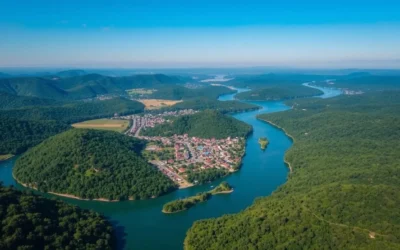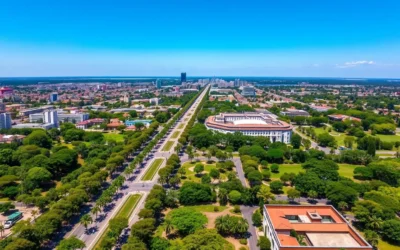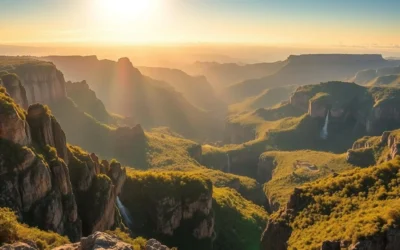Did you know that Manaus is home to an opera house built at the height of the rubber boom that was so lavish that materials and artists were imported directly from Europe? This “Paris of the Tropics” sits at the confluence of the Negro and Amazon rivers, serving as the gateway to the world’s largest rainforest. Despite being 900 miles inland from the Atlantic Ocean, Manaus is a major port city where ocean liners can dock, making it one of the most unique urban centers in South America. As you plan your journey to this fascinating Amazonian capital, prepare for an adventure that blends natural wonders with rich cultural heritage.
Getting There & Planning Your Journey
Most travelers reach Manaus by flying into Eduardo Gomes International Airport (MAO), which connects to major Brazilian cities like São Paulo, Rio de Janeiro, and Brasília. International travelers typically connect through these hubs, though there are some direct flights from Miami, Panama City, and Bogotá.
When planning your trip, consider allocating at least 3-4 days to explore Manaus itself, plus additional time if you want to venture deeper into the Amazon. Many visitors combine their city stay with a jungle lodge experience or river cruise.
Ready to start your Manaus adventure?
Find the best flight deals to Manaus from your location:
Best Time to Visit & Weather Tips

Manaus has a tropical rainforest climate with two distinct seasons: the rainy season (December to May) and the dry season (June to November). Each offers a unique experience for visitors:
Rainy Season (December-May)
- Higher water levels allow exploration of flooded forests (igapós) by boat
- Lush, vibrant vegetation throughout the region
- Ideal for river cruises and spotting wildlife near waterways
- Fewer tourists and potentially lower prices
- Frequent afternoon showers (pack rain gear!)
Dry Season (June-November)
- Better conditions for hiking and land-based activities
- Easier wildlife spotting as animals gather near water sources
- Perfect time to visit the Meeting of Waters phenomenon
- River beaches emerge as water levels drop
- More comfortable humidity levels
For the best balance of weather conditions and activities, consider visiting during the transitional months of May-June or November-December. These periods offer reasonable water levels for boating while maintaining good conditions for land exploration.
Getting Around Locally

Navigating Manaus offers a blend of urban transportation and unique Amazonian travel methods:
Public Transportation
The city has an extensive bus network that’s affordable but can be crowded. For tourists, the most useful routes connect downtown with major attractions like Ponta Negra Beach and the MUSA botanical garden. Buses display their routes on the windshield, and fares are paid directly to the conductor.
Ride-Sharing & Taxis
Ride-sharing apps like Uber and 99 operate throughout Manaus and provide a convenient, air-conditioned option with predictable pricing. Traditional taxis are also available but negotiate the fare before departing if the taxi doesn’t use a meter.
River Transport
Being an Amazonian city, water transportation is essential in Manaus. Small motorboats called “voadeiras” can be hired at the port for trips to nearby attractions like the Meeting of Waters. For longer journeys to riverside communities, larger boats depart regularly from the main port.
For exploring the historic center, walking is your best option as many attractions are within close proximity, particularly around Largo São Sebastião and the Teatro Amazonas.
Explore Manaus at your own pace
Rent a car to discover the accessible areas around the city:
Where to Stay in Manaus

Manaus offers accommodation options ranging from budget hostels to luxury hotels and unique jungle lodges. Here are the best areas to stay:
Centro Histórico (Historic Center)
Staying in the historic center puts you within walking distance of major attractions like Teatro Amazonas, Largo São Sebastião, and the Municipal Market. This area offers the most convenient location for sightseeing, with a range of hotels from budget to luxury.
Recommended Properties:
- Hotel Villa Amazônia – Boutique hotel with a natural stone pool and Amazon-inspired restaurant
- Juma Ópera Hotel – Luxury option directly across from Teatro Amazonas with a rooftop pool
- Local Hostel Manaus – Budget-friendly option with private rooms and dormitories
Adrianópolis & Vieiralves
These upscale neighborhoods offer modern accommodations, shopping centers, and excellent restaurants. While further from the historic sights, they provide a more residential experience with good transportation connections.
Recommended Properties:
- Manaus Hóteis Millennium – Connected to a shopping mall with a rooftop pool
- Quality Hotel Manaus – Business-oriented hotel with comfortable amenities
- Ibis Budget Manaus – Affordable option with consistent quality
Jungle Lodges
For an immersive Amazon experience, consider staying at a jungle lodge outside the city. These range from basic accommodations to luxury eco-resorts, offering guided excursions into the rainforest.
Find your perfect stay in Manaus
Browse accommodations for all budgets and preferences:
Dining & Local Cuisine

Manaus offers a unique culinary experience that showcases Amazonian ingredients and traditional techniques. The local cuisine features freshwater fish, exotic fruits, and indigenous herbs that you won’t find elsewhere in Brazil.
Must-Try Amazonian Dishes
- Tambaqui de Banda – Grilled tambaqui fish (a local favorite) served with regional side dishes
- Tacacá – A hot soup made with tucupi (fermented manioc juice), jambu leaves (which cause a tingling sensation), dried shrimp, and tapioca gum
- Pirarucu – Known as the “Amazon cod,” this large freshwater fish is prepared in various ways
- X-Caboquinho – A sandwich filled with coalho cheese and tucumã fruit, often served on French bread
- Açaí – Unlike the sweetened version found elsewhere, Amazonian açaí is traditionally served with tapioca, fish, or shrimp
Where to Eat in Manaus
Traditional Amazonian Cuisine:
- Tambaqui de Banda – Located in Largo São Sebastião with views of Teatro Amazonas
- Banzeiro – Upscale restaurant specializing in contemporary Amazonian cuisine
- Tacacá da Gisela – Famous spot for authentic tacacá in Largo São Sebastião
Local Experiences:
- Adolpho Lisboa Municipal Market – Food stalls serving fresh regional dishes
- Manaus Moderna Market – Less touristy market with authentic local food
- Glacial – Traditional ice cream shop offering Amazonian fruit flavors
Don’t miss the opportunity to try exotic Amazonian fruits like cupuaçu, tucumã, and bacuri, which are available at markets and juice bars throughout the city.
Attractions, Sightseeing & Activities
Historic Center Highlights
Manaus’s historic center showcases the city’s fascinating past as a rubber boom metropolis. Start your exploration at these key sites:
- Teatro Amazonas (Amazon Theatre) – This opulent opera house built during the rubber boom is Manaus’s most iconic landmark. Take a guided tour to learn about its history and see the impressive interior with its painted ceiling and European furnishings.
- Largo São Sebastião – The beautiful square surrounding the theater features the Monument to the Opening of the Ports, handicraft stores, and several excellent restaurants and bars.
- Adolpho Lisboa Municipal Market – Modeled after the Les Halles market in Paris, this iron structure houses vendors selling regional products, handicrafts, and local foods.
- Manaus Port – The bustling port offers a glimpse into daily Amazonian life, with boats arriving loaded with products from riverside communities. Visit at sunset for spectacular views.
Discover the best of Manaus
Book guided tours to maximize your experience:
Natural Wonders

The natural attractions surrounding Manaus are truly world-class:
- Meeting of Waters (Encontro das Águas) – This remarkable phenomenon occurs where the dark Rio Negro meets the sandy-colored Solimões River (Amazon). Due to differences in temperature, speed, and density, the two rivers flow side by side for several kilometers without mixing, creating a striking visual boundary.
- Janauari Ecological Park – Located near the Meeting of Waters, this flooded forest reserve features water lilies, diverse wildlife, and wooden walkways for exploration.
- MUSA (Museum of the Amazon) – This botanical garden within the Adolpho Ducke Forest Reserve offers a 42-meter observation tower providing panoramic views over the rainforest canopy, plus walking trails and exhibits about Amazonian biodiversity.
- Ponta Negra Beach – This urban beach along the Rio Negro offers a place to relax, swim (during low water season), and enjoy sunset views.
Museums, Cultural Spots & Festivals

Museums & Cultural Institutions
- Palácio Rio Negro – Former rubber baron’s mansion turned cultural center with period furnishings and historical exhibits
- INPA (National Institute of Amazonian Research) – Scientific institution with exhibits on Amazonian wildlife, including manatees and giant otters
- Seringal Vila Paraíso – Rubber plantation museum showcasing the extraction process and living conditions during the rubber boom
- Centro Cultural Povos da Amazônia – Cultural center dedicated to the indigenous peoples of the Amazon region
- Galeria do Largo – Art gallery near Teatro Amazonas featuring works by local artists
Festivals & Events
Manaus hosts several vibrant festivals throughout the year:
- Amazonas Opera Festival (April-May) – International opera performances held at the Teatro Amazonas
- Boi Manaus (October) – Festival celebrating the city’s anniversary with music and dance
- Festival de Parintins (June) – While held in Parintins (accessible by boat from Manaus), this famous folklore festival attracts many visitors who use Manaus as their base
- Amazonas Film Festival (November) – International film festival showcasing Brazilian and international cinema
For an authentic cultural experience, check the schedule at Teatro Amazonas during your visit, as they frequently host free or low-cost performances ranging from classical music to regional dance.
Sports, Nature & Outdoor Experiences

Amazon Rainforest Experiences
The primary reason many travelers visit Manaus is to experience the Amazon rainforest. Several options are available:
- Day Trips – Perfect for those with limited time, these typically include a visit to the Meeting of Waters and a short jungle walk
- Jungle Lodges – Stay in accommodations ranging from basic to luxury within the rainforest, with guided activities included
- River Cruises – Multi-day journeys along the Amazon and its tributaries, offering comfort while exploring remote areas
- Survival Tours – More adventurous experiences teaching rainforest survival skills and deeper immersion
Water Activities

- Flooded Forest (Igapó) Exploration – During high water season, boat trips through the flooded forest offer a unique perspective
- Swimming with Pink Dolphins – While popular, this activity is controversial due to potential negative impacts on the animals
- Fishing Excursions – Guided fishing trips to catch Amazonian species (catch and release options available)
- SUP and Kayaking – Available at locations like Abaré SUP & Food, a floating bar and activity center
Nearby Natural Attractions
- Presidente Figueiredo – Known as “the land of waterfalls,” this town is located about 2 hours from Manaus and features numerous waterfalls, caves, and hiking trails
- Anavilhanas Archipelago – The world’s largest river archipelago, with hundreds of islands that can be explored by boat
- Rio Preto da Eva – Area with clear water streams and natural swimming holes
Safety, Etiquette & Local Customs

Safety Tips
Manaus is generally welcoming to tourists, but like any large city, it’s important to take precautions:
- Stick to well-traveled areas, especially at night
- Use ride-sharing apps or official taxis rather than hailing cabs on the street
- Keep valuables secure and avoid displaying expensive cameras or jewelry
- Withdraw money from ATMs inside banks or shopping centers during daylight hours
- Carry only the cash you need for the day and keep it in separate places
- Be cautious in crowded areas like markets where pickpocketing can occur
Health Considerations
- Yellow fever vaccination is recommended (though not required) for travel to the Amazon region
- Malaria risk is low in Manaus itself but increases in remote areas; consult with a travel doctor about prophylaxis
- Stay hydrated in the hot, humid climate
- Use insect repellent, especially during dawn and dusk hours
- Drink bottled or filtered water
Cultural Etiquette
Understanding local customs enhances your experience:
- Greetings are important; a handshake or kiss on the cheek is common
- Brazilians value personal relationships; small talk before business is expected
- When visiting indigenous communities, follow guide instructions and ask before taking photos
- Tipping is customary (10-15% in restaurants, though it’s often included as “serviço”)
- Casual dress is acceptable in most situations, but modest attire is appropriate for churches
Practical Travel Tips

What to Pack
- Lightweight, quick-drying clothing (long sleeves and pants for jungle excursions)
- Comfortable walking shoes plus sandals or water shoes
- High-SPF sunscreen and insect repellent with DEET
- Wide-brimmed hat and sunglasses
- Raincoat or poncho (especially during rainy season)
- Reusable water bottle
- Basic first aid kit
- Waterproof bag or case for electronics
Communication
Portuguese is the official language in Brazil. While English is spoken in some tourist establishments, learning a few basic Portuguese phrases will enhance your experience. Mobile coverage is good in Manaus, but may be limited or non-existent in remote jungle areas. Consider purchasing a local SIM card for affordable data and calls within Brazil.
Money Matters
- The Brazilian currency is the Real (BRL)
- Credit cards are widely accepted in hotels, restaurants, and larger stores
- Carry cash for markets, small establishments, and tips
- Inform your bank of your travel plans to prevent card blocks
- ATMs are available throughout the city, but some have withdrawal limits
Time Management
Brazilians have a more relaxed approach to time than some cultures. Tours and services may not always start exactly on schedule, so build some flexibility into your itinerary. For jungle excursions, book in advance, especially during high season (July-August and December-January).
Conclusion

Manaus offers a truly unique travel experience that combines the wonders of the Amazon rainforest with fascinating cultural heritage. From watching an opera performance in the magnificent Teatro Amazonas to witnessing the Meeting of Waters and exploring flooded forests, the city provides unforgettable experiences that can’t be found elsewhere.
Whether you’re an adventure seeker looking to explore the depths of the Amazon, a culture enthusiast interested in the region’s rich history, or a nature lover eager to witness incredible biodiversity, Manaus delivers on all fronts. The city’s blend of natural wonders, historical significance, and authentic Amazonian culture makes it one of Brazil’s most rewarding destinations.
As you plan your journey to this gateway to the Amazon, remember that the true magic of Manaus lies in its contrasts – a modern city surrounded by the world’s largest rainforest, a place where rivers of different colors flow side by side without mixing, and where European architecture stands amid tropical splendor. Prepare to be amazed by the unique experiences that await in this remarkable Amazonian capital.
Ready to experience Manaus?
Start planning your Amazon adventure today:
The above is subject to change.
Check back often to TRAVEL.COM for the latest travel tips and deals.






